Diana Renn
Mysteries that Matter
Weekend Reads
 This weekend I hope to finish up an audio book that I’ve been immersed in lately: A SONG CALLED HOME, the new middle grade novel by award-winning author Sara Zarr.
This weekend I hope to finish up an audio book that I’ve been immersed in lately: A SONG CALLED HOME, the new middle grade novel by award-winning author Sara Zarr.Weekend Reads
This week I’m kicking off a hopefully weekly series on the blog, featuring my “weekend reads.” These are books I’m hoping to dig into over the weekend or am currently reading. Or just plain excited about.
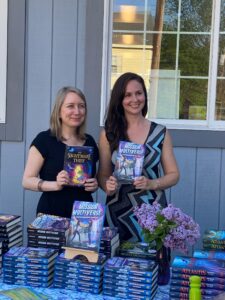
Authors Rebecca Caprara and Nicole Lesperance celebrating sequels!
Lately, I am excited about brave people saving the world, for probably obvious reasons. That’s why I love Rebecca Caprara’s Mission Multiverse books so much, as they feature middle grade marching band misfits, a.k.a. the Space Cadets, saving not just our world but many worlds: the multiverse. I loved Book One for its fabulous ensemble cast of unlikely heroes, as well as some of the most creatively rendered extraterrestrials I’ve ever met in fiction. Book 2 came out this week, Mission Multiverse: Doppelgänger Danger, in which our intrepid Space Cadets are now trapped on an alternate version of earth and learn that a doppelgänger is among them. In full disclosure, Rebecca is a dear friend and critique partner, so I’ve been in on the multiverse from its earliest inception, when it was more space dust ideas then book. It’s been such a fun ride to see both of these books take shape.
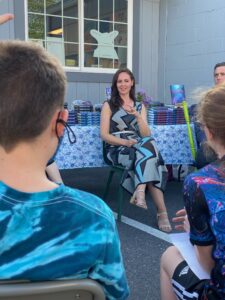
Rebecca explains the multiverse.
Publishing takes a long time, and while her stories are familiar to me, I have forgotten some details. (Or maybe I am somewhere in the Multiverse still reading some other version?!) Also, i know Rebecca has revised over time, with her editor. Also, I love doppelgänger and double stories, so there’s no harm in reading this twice.

Delicious stacks of books at the Silver Unicorn Bookstore panel on middle grade sequels, featuring Rebecca’s Mission Multiverse series, Nicole’s Dream Spies series, and Gregory Mone’s Atlantis series – can’t wait to dive into all these fascinating worlds!
And I am eager to see how the final version turned out. It is always such a joy to hold a friend’s finished book in my hand and know the journey it’s been on . . . in Rebecca’s case, an interplanetary, intra-dimensional one! I’m happy to have been a part of that ride in some small way and was honored to read her earliest pages.
I highly recommend this book and series for kids who love Space adventures, band culture, friendship stories, and adventurous kids with lots of heart.
Click here to order a SIGNED copy of the Mission Multiverse series at Silver Unicorn Books!
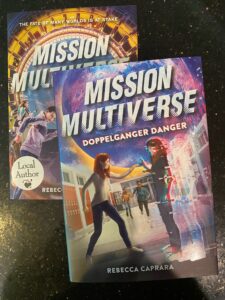
Rounding out Citizen Science Month!
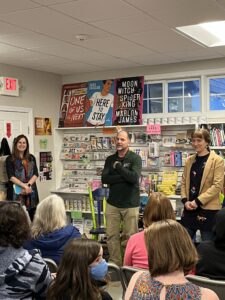
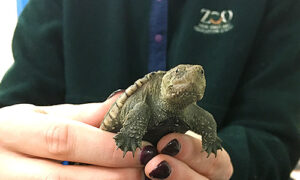
Image courtesy of Zoo New England
increasing the odds that each turtle cared for will survive to adulthood. At the same time, students collect and analyze data on hatchlings’ growth while learning about the ecology and importance of our freshwater wetlands. By helping protect native biodiversity and restoring healthy wetlands in their communities, students learn that they can be agents of change in a small but significant way.”

I loved chatting with Sheela Chari, Elaine Dimopoulos, and Author’s Note bookstore owner Julie Berry — who is also an award-winning children’s book author!
You can find the playback link here if you’d still like to tune in.
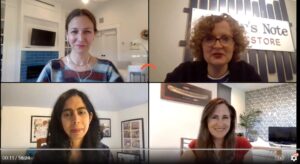
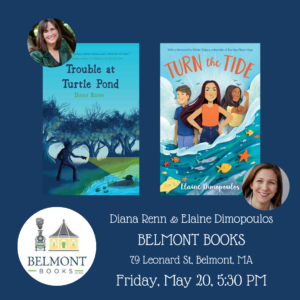
#Reallifebackyardranger Cody Herrmann
![]() Meet Cody Herrmann!
Meet Cody Herrmann!
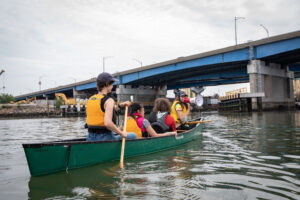
Cody Herrmann (she/her) is a New York City based artist and community organizer. She combines socially engaged art, politi
cal advocacy, and community science to create participatory art works and public programs. Since 2014 her work has focused on her hometown of Flushing, Queens, NYC, creating projects critiquing policy related to land use and environmental planning in areas surrounding Flushing Bay and Flushing
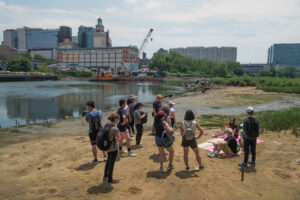
Creek. She frequently hosts both on-land and on-water tours of the area, while creating artworks such as beach towels and temporary tattoos that allow viewers to visualize water quality test results. Cody is a board member of Guardians of Flushing Bay, and a long time volunteer sampler for the Citizens Water Quality Testing program in NYC. Visit Cody’s website to view her work. Click here to learn more about Guardian’s of Flushing Bay! ![]()
![]()
![]()
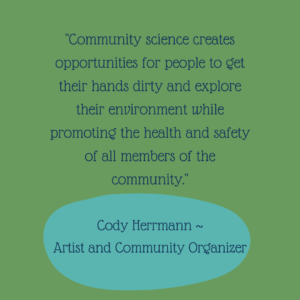
Trouble at Turtle Pond in the world!
Trouble at Turtle Pond has been in the world for over a week! I’m so grateful to everyone who came out to the launch at Silver Unicorn, including Loree Griffin Burns, and the team from Zoo New England.
.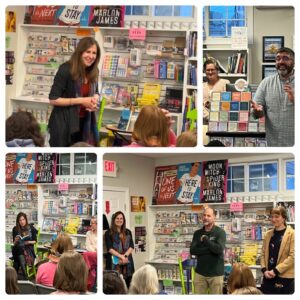
There are still signed copies available at Silver Unicorn. They’ll even ship you a signed copy! Click here to order.
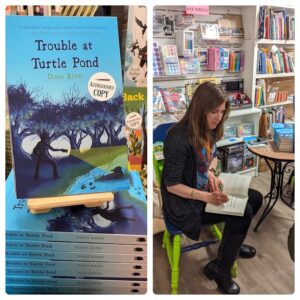
Trouble at Turtle Pond has also been featured on WBUR Radio Boston! I loved chatting with Zoo New England’s Field Conservation Program Manager Emilie Wilder about the HATCH program, and how it helped inspire the book. Listen to the full interview here.
In other audio news, Fitzroy Books / Regal House publisher Jaynie Royal (also my editor!) sat down with me and two fellow Fitzroy authors, Frank Morelli and Ginger Park, to talk about middle grade fiction, gatekeepers, balancing research with story, and broccoli books! (You’ll have to listen to find out what that is!) Jaynie wears many hats, and podcast host is definitely one of them! Check out the full recording on Conspiracy of Lemurs here.
I’ve also been busy pumping out various Trouble at Turtle Pond related blog post through the lens of teaching, publishing, and middle grade writing. Thanks Teaching Books, Middle Grade Book Village, and Smack Dab in the Middle for featuring my words.
THANK YOU to Regal House and Fitzroy Books for believing in this story. The paperbacks are beautiful and high quality as well, and available through the publisher and through retail stores, but what I love about Regal house is they make the hard cover available for those who want it. Click here to order.
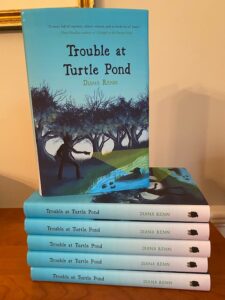
Lastly: what can you, lovely readers, do to continue supporting this project? First, you can grab a copy from my favorite local indie bookstore, Silver Unicorn! You can then head over to Goodreads and Amazon to leave a review. These reviews make a huge difference in making sure the book gets seen. You can also request it at your local bookstore.
Thanks, everyone! Go #teamturtle!
#Reallifebackyardranger Maribel Pregnall Mueller
Meet Maribel Pregnall Mueller!
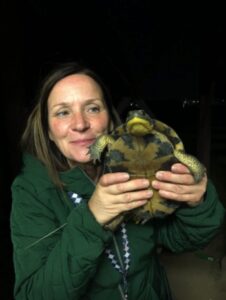
Maribel grew up in northern Vermont, Oregon, and the coast of Maine. She was the kind of kid who never could stay inside too long. Her adventures outside gave her an appreciation for nature that shaped her life and career. It led her to whale research, then to outdoor education, and then to a long career teaching public high school science. She is now a retired science teacher from Arlington High School in LaGrangeville, NY, where she taught for 30 years. During her career she integrated hands-on science and outdoor adventure into her teaching whenever she could. Fortunately for her, that made her career lots of fun and brought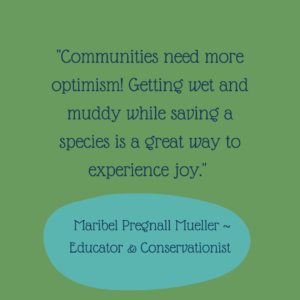 her to some really cool places. She brought her students to Alaska, Hawaii, Costa Rica and Key Largo, Florida to study the flora and fauna in super diverse ecosystems. They climbed mountains in Denali National Park and went SCUBA diving on coral reefs in Marine sanctuaries. She also worked with her students to battle invasive species in a local park, to work with college professors on endocrine disrupters in our personal care products, and to build an Aquaponics laboratory in her classroom.
her to some really cool places. She brought her students to Alaska, Hawaii, Costa Rica and Key Largo, Florida to study the flora and fauna in super diverse ecosystems. They climbed mountains in Denali National Park and went SCUBA diving on coral reefs in Marine sanctuaries. She also worked with her students to battle invasive species in a local park, to work with college professors on endocrine disrupters in our personal care products, and to build an Aquaponics laboratory in her classroom.
The most rewarding project in her career, however, was working to save a species that lived in the wetlands behind her school. For most of her career, she worked with hundreds of students to save a New York threatened species, the Blanding’s turtles, 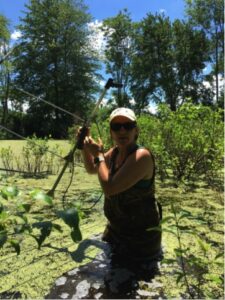 from local extinction. In her retirement, she is still working on the Blanding’s turtle project and working with student interns during nesting season. She is also on the Board of The Wetland Trust where they purchase valuable wetland habitat and mitigate when there is damage to wetland habitats during development. She is also on the Board of The Friends of Peach Hill where she is working on creating pollinator meadows and building an outdoor education classroom in a local town park they saved from becoming a housing development. In her career and now in retirement, she will always be a champion for the earth. Her life and mission to help and study the environment are intertwined.
from local extinction. In her retirement, she is still working on the Blanding’s turtle project and working with student interns during nesting season. She is also on the Board of The Wetland Trust where they purchase valuable wetland habitat and mitigate when there is damage to wetland habitats during development. She is also on the Board of The Friends of Peach Hill where she is working on creating pollinator meadows and building an outdoor education classroom in a local town park they saved from becoming a housing development. In her career and now in retirement, she will always be a champion for the earth. Her life and mission to help and study the environment are intertwined.
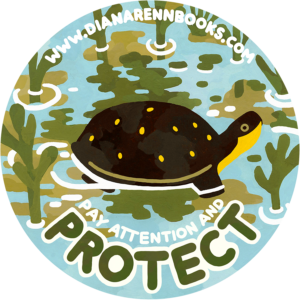
Q&A with Artist Franco Zacharzewski

Franco Zacharzewski and I met at Creature Conserve, which brings artists, creative writers, and scientists together to “study, celebrate, and protect animals and their habitats.” His illustrations address everything from climate anxiety and mental illness, to Uyghur cooking. His striking colors, textures, and subject matter always draw me in. So when he agreed to create a graphic for TROUBLE AT TURTLE POND, I was ecstatic, and equally excited when he agreed to answer a few questions for the blog. We also get a sneak peak into his studio where the magic happens!
Q: What got you into conservation work?
A: My generation grew up with a lot of great T.V. programming on the natural world. As a kid, my curiosity for animals was definitely sparked by Animal Planet and Discovery Channel shows. More recently though, I feel like my interest in conservation has been fueled by the professors I met in college that have been working in this field for a long time.
Q: How do you use art in service of conservation?
A: Art speaks to us in a way nothing else does. Even at its most representational and literal, I think art is always imbued with a sentiment that can only be felt. With that in mind, I try to use art to strike a chord with people in a way science can’t. Not to tell people about the value of wildlife conservation—to show them.
Q: What does conservation mean to you as an artist?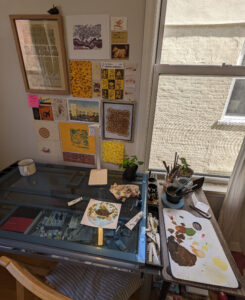
A: I’m not sure how my meaning of conservation differs to a scientist’s, or anyone else’s for that matter. In broad terms, I guess I see it as the responsibility to understand the creatures we share our planet with and work towards providing them with the best quality of life possible. As an artist, I’d say I channel that responsibility into making pictures.
Q: What inspires you?
A: Lately I’ve been inspired by cities and the stories unfolding in them. I like how small cities can make me feel, and in turn, how small a city can feel in relation to nature. There are so many fun visual compositions too that it’s hard not to find something to draw.
Q: What’s your favorite animal to draw?
Jaguars!
Q: If you could say one thing to a young artist who wants to use their art for activism, what would you tell them?
A: If I had to summarize, I’d say: Art for activism is an act of love, so love wholeheartedly. Do your research. Make sure you understand what the issues are and how your art addresses them. Ask the affected community about their needs, see if they have proposed any solutions already. Assess how your art will impact the community who you are trying to support. And be ready to make mistakes, and correct them.
Q: What was fun about designing this image?
A: My favorite part was finding out how to use the least number of colors and shapes to convey the Blanding’s Turtle’s habitat and personality. I really appreciate the humility in trying to make an image as simple and clear as possible so that the greatest number of people can understand it.
Q: Did any unexpected challenges come up when creating this image and if so, what?
A: Designing text was something new for me! It was exciting to find ways to accommodate both the type and the art in a relatively small image. I had to be mindful of striking a balance between retaining the most important elements in the frame and making the text legible when printed.
Q: What’s your process like when you come up with ideas? What goes into your thinking?
A: As of recently, I’ve been trying to start my compositions from photographs. I like to get lost in pictures and find the painting within them. Then it’s just a matter of removing elements from the frame until I am left with the most synthesized composition possible.
 Franco Zacharzewski is an Argentinian illustrator raised in Paraguay, Colombia, and the United States. He graduated from the Rhode Island School of Design and is currently based in Brooklyn, NY. Franco is an advocate for climate action and environmental justice. He is currently the art director at Creature Conserve. Occasionally, you may find him relaxing by the waters of Prospect Park Lake.
Franco Zacharzewski is an Argentinian illustrator raised in Paraguay, Colombia, and the United States. He graduated from the Rhode Island School of Design and is currently based in Brooklyn, NY. Franco is an advocate for climate action and environmental justice. He is currently the art director at Creature Conserve. Occasionally, you may find him relaxing by the waters of Prospect Park Lake.
#Reallifebackyardranger Robert Shao
Meet Robert Shao!
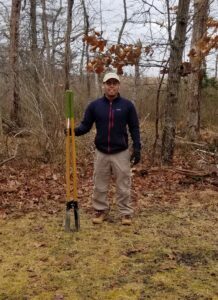
Robert Shao is a Land Steward for The Nature Conservancy in New York, based off the East End of Long Island. He earned his Bachelors in Environmental Studies from SUNY Purchase and worked as a Fish & Wildlife Technician with the New York State Department of Environmental Conservation prior to joining The Nature Conservancy.
And what is a Land Steward, you ask? A Land Steward, to put it simply, is someone who takes care of the land! They make sure the building blocks of a healthy ecosystem are in place. For example: they monitor the soil to ensure it’s healthy, check for biological diversity, and keep tabs on the water and air to ensure it’s clean. In essence, they are masters at paying attention and protecting.
You can support The Nature Conservancy by visiting their site and checking out their programming!

One week till launch day!
Dear Readers,
 There’s just one week until the launch of TROUBLE AT TURTLE POND, out from Fitzroy Books / Regal House on April 5!
There’s just one week until the launch of TROUBLE AT TURTLE POND, out from Fitzroy Books / Regal House on April 5!
I’m excited to share that TROUBLE AT TURTLE POND has been getting some love from news outlets, including my local newspaper, The Concord Journal!
The article is also online, if you’d like to give it a click.
I’ve also got a piece out on Zoo New England’s Field Conservation blog. Read on for a teaser!
How Volunteering with Blanding’s Turtles Hatched a Book Idea
“The road to writing my mystery novel for children, Trouble at Turtle Pond, began with a turtle. Soon after my family and I moved to Concord, Massachusetts, I swerved to avoid a large snapping turtle in our street. I had never seen one before. Nor would I have believed that turtles were about to enter my life in a big way.”
#RealLifeBackyardRanger Emilie Wilder
Meet Emilie Wilder!
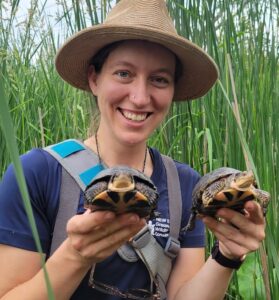 Emilie manages local rare species conservation projects for Zoo New England. Emilie works with turtles, frogs, salamanders, and even rare plants, figuring out what’s going on with their populations and finding ways to help them. For example, the two turtles she’s
Emilie manages local rare species conservation projects for Zoo New England. Emilie works with turtles, frogs, salamanders, and even rare plants, figuring out what’s going on with their populations and finding ways to help them. For example, the two turtles she’s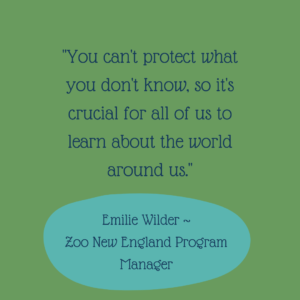 holding are rare Blanding’s turtles. They got a “headstart” in life – raised in a local classroom as tiny hatchlings until they were bigger and stronger – and now she’s releasing them back into the swamp. These turtles are the next generation that will hopefully grow up to continue the population and keep our local swamps full of beautiful diversity.
holding are rare Blanding’s turtles. They got a “headstart” in life – raised in a local classroom as tiny hatchlings until they were bigger and stronger – and now she’s releasing them back into the swamp. These turtles are the next generation that will hopefully grow up to continue the population and keep our local swamps full of beautiful diversity.
You can support Emilie and her work by visiting the Zoo New England site.
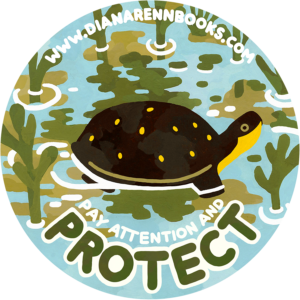
Diana Renn Author | Website Content Copyright © 2024 | Privacy Policy